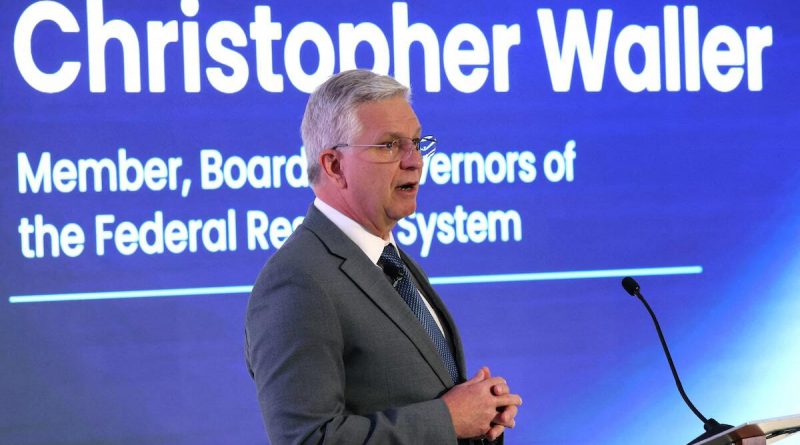Fed Eyes New Era in Payments: Waller Champions ‘Streamlined Payment Accounts’ for a Modern Economy
Federal Reserve Governor Christopher Waller unveils a visionary plan to open up the U.S. payment system — blending innovation, access, and stability in the digital age.
In a move that could reshape the landscape of financial innovation, Federal Reserve Governor Christopher Waller has revealed that the Fed is exploring the creation of a new type of account designed to expand access to its payment systems beyond traditional banks.
Speaking at a central bank payments conference in Washington, Waller outlined a prototype concept called the “payment account” — a simplified version of the Fed’s traditional master accounts that could enable fintech firms, payment companies, and non-bank entities to access the Fed’s payment rails in a limited, regulated way.
This development signals a bold step toward modernization of the U.S. financial infrastructure, reflecting the Fed’s recognition that the future of payments is evolving rapidly — and the central bank must evolve with it.
Balancing Innovation with Prudence
Waller emphasized that the proposal remains in its early, exploratory phase, but its potential impact could be transformative.
The goal is to strike a delicate balance — promoting competition and efficiency in the payments sector while safeguarding financial stability.
“Payments innovation moves fast, and the Federal Reserve needs to keep up,” Waller said during his keynote remarks.
For years, fintechs and non-bank payment firms have sought direct access to the Fed’s real-time payments infrastructure, which is currently restricted to banks and select institutions.
However, granting such access has been controversial, as it involves complex regulatory oversight and potential systemic risks.
The payment account model aims to solve this dilemma — creating a “skinny” master account that offers limited access to the Fed’s core payment network, without granting the full privileges and protections enjoyed by banks.
How the ‘Payment Account’ Could Work
According to Waller, these accounts would function as streamlined tools for payment processing rather than full-fledged banking accounts. They could:
- Be limited in size, preventing excessive risk exposure.
- Not pay interest or allow overdrafts, minimizing financial dependency on the Fed.
- Exclude access to the discount window and other emergency lending facilities.
However, they could offer faster payment capabilities, greater transparency, and simplified regulatory reviews, helping smaller and innovative firms connect directly to the Fed’s system without relying on intermediary banks.
This proposal could make the U.S. payments ecosystem more inclusive, efficient, and resilient, allowing technology-driven companies to innovate within a clear and controlled framework.
Why It Matters for the U.S. Economy
The introduction of payment accounts could have wide-reaching benefits. It could reduce costs for businesses that depend on third-party access, enhance competition in digital payments, and improve consumer choice in how money moves.
For fintechs and payment startups, it could mean the difference between indirect participation and direct innovation. With streamlined access to Fed systems, they could offer faster, cheaper, and safer payment services — advancing financial inclusion for underserved communities.
At the same time, the proposal could strengthen the resilience of the payments network, providing more redundancy and innovation-driven efficiency. In a financial system increasingly powered by digital platforms, these changes align with the Fed’s mission to maintain stability, accessibility, and public trust.
Keeping Pace with Global Change
Globally, central banks are rethinking their roles in digital finance. From Europe’s instant payment networks to Asia’s real-time digital settlements, competition and innovation are redefining how economies move money.
The Federal Reserve, traditionally seen as cautious in its approach to financial innovation, is now signaling agility and openness. Waller’s remarks show that the Fed wants to ensure the U.S. remains a leader in payments technology and financial infrastructure.
By exploring limited-access accounts, the Fed can test new mechanisms safely — fostering innovation without compromising the stability of the nation’s banking system.
Waller chairs the Fed’s internal payments committee, which oversees research and strategy on emerging financial technologies. His advocacy for the payment account reflects a forward-looking vision: one where regulation supports innovation instead of stifling it.
“The payments landscape, as well as the types of providers, has evolved dramatically in recent years,” Waller noted. “A new payments account could better reflect this new reality.”
His comments also echo broader efforts by the Fed to modernize payment systems, including the launch of FedNow, its instant payment service, in 2023. Together, these initiatives show a central bank adapting to a new digital era — thoughtfully, yet decisively.
The Fed Steps into the Future
The payment account concept may still be on the drawing board, but it already represents a paradigm shift in how the Federal Reserve views access and innovation.
By embracing modernization while maintaining its cautious oversight, the Fed is sending a powerful message: the future of money is open, digital, and inclusive — and America’s central bank intends to help shape it.
As Waller leads the charge, the U.S. may soon see a more dynamic and democratized payments ecosystem — one that combines the trust of the Fed with the creativity of the private sector.



